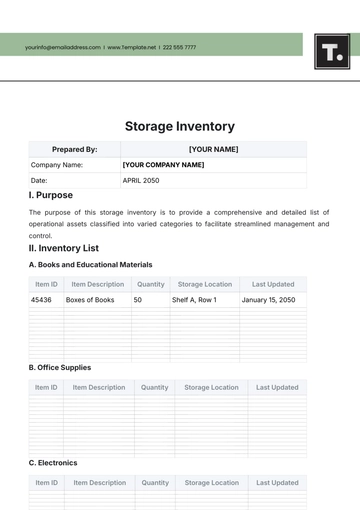Free Printable Inventory Turnover Report

Company: [Your Company Name]
Prepared by: [Your Name]
Report Period: [Date]
I. Introduction
This report provides a comprehensive analysis of the inventory turnover for the current fiscal year. It aims to evaluate how efficiently the company is managing its inventory by examining the rate at which inventory is sold and replaced over a specific period. The findings in this report will aid in decision-making processes concerning inventory management strategies.
II.Understanding Inventory Turnover
Inventory turnover is a critical metric in assessing operational efficiency and financial health. It indicates how often inventory is sold and restocked over a set period, reflecting the company's sales efficiency and inventory management. A high turnover rate suggests effective management and high demand, while a low turnover rate could indicate overstocking or issues with product demand.
A. Calculation of Inventory Turnover Ratio
The inventory turnover ratio is calculated using the formula:
Inventory Turnover Ratio = Cost of Goods Sold (COGS) / Average Inventory
The average inventory is determined as follows:
Average Inventory = (Beginning Inventory + Ending Inventory) / 2
B. Importance of Inventory Turnover
An optimized inventory turnover rate can lead to reduced holding costs, improved cash flow, and increased profits. It helps businesses avoid situations where capital is tied up in unsold goods and minimizes the risk of inventory obsolescence.
III. Data Summary
The following sections provide detailed insights into the inventory turnover trends observed in the current fiscal year based on sales data and inventory records.
Month | Beginning Inventory ($) | Ending Inventory ($) | COGS ($) | Inventory Turnover Ratio |
|---|---|---|---|---|
January | 50,000 | 45,000 | 200,000 | 4.44 |
February | 45,000 | 48,000 | 180,000 | 4.00 |
March | 48,000 | 52,000 | 220,000 | 4.58 |
April | 52,000 | 50,000 | 210,000 | 4.42 |
A. Monthly Analysis
Analysis of the captured data reveals certain trends in inventory turnover. The month of March witnessed the highest turnover, primarily attributable to increased sales volume and efficient inventory restocking measures. Conversely, February displayed a slight dip, indicating potential areas for improvement in sales strategies or inventory sourcing.
IV. Key Findings
Overall, the average inventory turnover for the current fiscal year stands at 4.36, indicating a fairly healthy rate of turnover across the months.
Significant variance was observed month-to-month, prompting consideration of seasonal demand fluctuations.
The most efficient inventory management was noted in March, with a turnover ratio surpassing the overall average.
February's lower turnover suggests a need for targeted strategies to boost sales and streamline inventory management during slower periods.
V. Recommendations
Based on the analysis of inventory turnover during the reported period, the following recommendations are provided:
Enhance demand forecasting methods to better align inventory acquisition with customer demand patterns.
Continue to monitor inventory levels closely and reduce overstocking by optimizing reorder points and quantities.
Implement marketing and promotional activities during months with historically lower sales turnover to stimulate demand.
Consider lean inventory management practices to reduce holding costs without compromising product availability.
VI. Conclusion
The inventory turnover report reflects the company’s overall effectiveness in managing its inventory. While the current turnover ratios suggest healthy operations, there is room for improvement. Implementing the suggested recommendations can lead to enhanced efficiency, reduced costs, and improved profitability. Continuous monitoring and adaptation to changing market conditions will be crucial for sustained success in inventory management.
- 100% Customizable, free editor
- Access 1 Million+ Templates, photo’s & graphics
- Download or share as a template
- Click and replace photos, graphics, text, backgrounds
- Resize, crop, AI write & more
- Access advanced editor





























